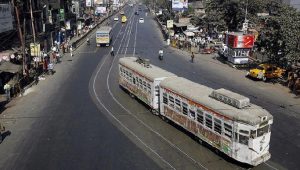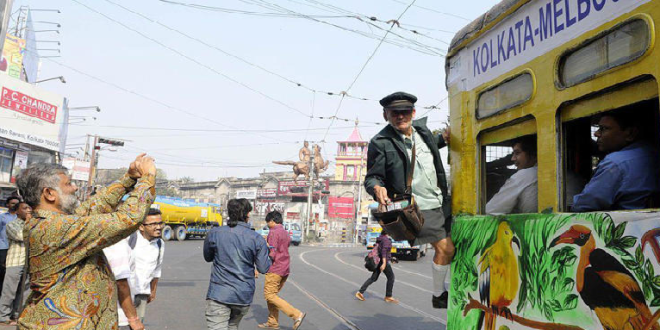04-10-2024
Bureau Report + Agencies
NEW DELHI/ KOLKATA: Last week, authorities in the Indian city of Kolkata announced plans to eliminate trams entirely, retaining only a small heritage loop. In response, a group of activists is fighting to ensure that trams remain a vital mode of transport rather than mere nostalgic joyrides. Sandip Roy reports.
 In February 2023, Kolkata celebrated 150 years of its tramways with music, cake, a beauty parade of vintage trams, including a century-old wooden car, and a cheerful tram conductor, Roberto D’Andrea, who travelled all the way from Melbourne, Australia.
In February 2023, Kolkata celebrated 150 years of its tramways with music, cake, a beauty parade of vintage trams, including a century-old wooden car, and a cheerful tram conductor, Roberto D’Andrea, who travelled all the way from Melbourne, Australia.
Melbourne and Kolkata boast two of the oldest operational tramways in the world. Melbourne’s trams date back to 1885. Kolkata’s first tram, a horse-drawn one, started in 1873. That’s where the similarities end.
Melbourne’s tram system is going strong despite the government once attempting to get rid of them. The system has been upgraded and some trams are solar-powered.
Kolkata’s trams have been steadily declining over the years. From 52 routes in the 1970s, down to 25 in 2015 and now to just three.
The tram cars rattle and wheeze, having not been updated in years. Even the signs inside have not changed. “Beware of pickpockets”, “No change available for 100 rupees ($1.19; $0.89) or 50” and “To stop the car please ring the bell only once”.
Now, the state government has announced that it wants to do away with trams entirely, save for one small loop as a heritage route but a dogged group of tram activists is fighting back.
“It’s a huge backward step as cities worldwide are ‘decarbonising transport’ because of global warming and climate change,” says D’Andrea, who has helped foster a Kolkata-Melbourne tram friendship over the years.
 “More than 400 cities run tram systems. Cities that dismantled their tramways are rebuilding them at great expense in places like Sydney and Helsinki and all over France. Hong Kong runs trams at high frequency on narrow streets,” he says but West Bengal transport minister Snehasis Chakraborty told the media: “The population and vehicular count of Kolkata have multiplied several times but the city’s roads have not widened. Road space continues to hover around 6% which is way less than Mumbai’s 18% and Delhi’s 10%.”
“More than 400 cities run tram systems. Cities that dismantled their tramways are rebuilding them at great expense in places like Sydney and Helsinki and all over France. Hong Kong runs trams at high frequency on narrow streets,” he says but West Bengal transport minister Snehasis Chakraborty told the media: “The population and vehicular count of Kolkata have multiplied several times but the city’s roads have not widened. Road space continues to hover around 6% which is way less than Mumbai’s 18% and Delhi’s 10%.”
Both those cities once had trams. Mumbai had double-decker ones. Both have done away with them, leaving Kolkata as the only Indian city to hold onto the trundling streetcars. In a way they have become emblematic of the city itself.
The city has other landmarks, the steel Howrah Bridge, the white-domed Victoria Memorial monument, the colonial buildings in the city’s centre but just as London has its iconic red double-decker buses, Kolkata has its trams. The ding-ding sound of the first tram of the day rattling down streets was the alarm clock many in Kolkata woke up to. They are a familiar sight in films made in the state.
“I have used trams in two of my films and the tram depot as well,” says filmmaker Anjan Dutt.
Mahanagar (1963), by celebrated filmmaker Satyajit Ray, opens with a stunning two-minute-long tram sequence, sparks flying from the overhead cables before the camera moves inside to settle on the protagonist’s tired face as he returns home from work. Here, the tram stands in for the city itself, both its dreams and the daily grind. In fact, Kolkata’s Belgachia tram depot, once bustling with workmen repairing, maintaining, even building trams, nowadays often doubles as a film set. “Even on a working day I saw films being shot in the workshop,” says Subir Bose, a tram company worker who retired in 2022 after 39 years of service. “A Kolkata film means they have to show a tram.”
 Pressmediaofindia
Pressmediaofindia




